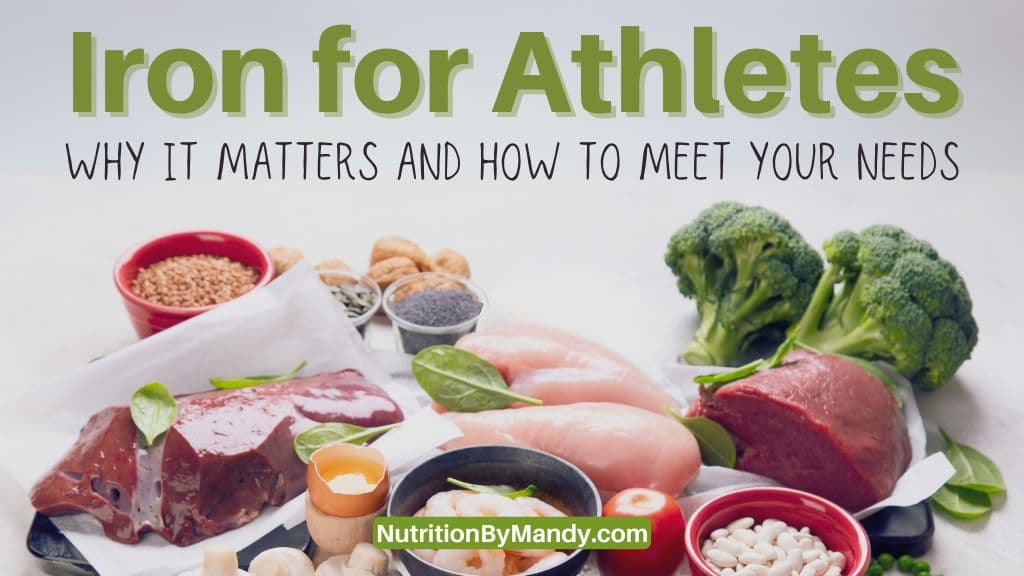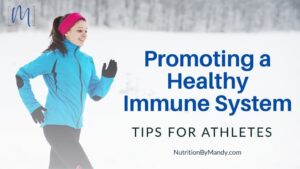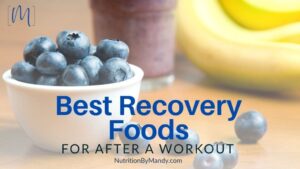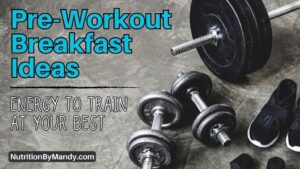Last Updated on February 24, 2025 by Mandy Tyler, M.Ed., RD, CSSD, LD
Iron for Athletes: Why It Matters and How to Meet Your Needs
Iron is an essential nutrient for athletes, important for both health and sports performance. Unfortunately, iron is often a nutrient that gets overlooked by athletes until a deficiency occurs.
Let’s explore why iron is important for athletes as well as ways to support athletes with meeting their daily iron needs.
Importance of Iron for Athletes
Iron is an essential mineral with many important roles in the body. It is needed by the body to form hemoglobin, a component of red blood cells. Hemoglobin helps transport oxygen throughout the body (1).
Iron is also necessary for the formation of myoglobin, which helps transport oxygen to working muscles during exercise (1).
In addition to transporting oxygen in the body, iron is necessary for (1, 2, 3):
- Energy production
- Maintaining a healthy immune system
- Forming connective tissue
- Producing hormones
- Cognitive function

What Are the Iron Needs of Athletes?
The amount of iron an athlete needs depends on both the athlete’s age and sex. The Recommended Dietary Allowances(RDAs) for iron are listed below (4).
Males – Iron Recommended Dietary Allowance
- Age 9-13 years: 8 mg/day of iron
- Age 14-18 years: 11 mg/day of iron
- Age 19+ years: 8 mg/day of iron
Females – Iron Recommended Dietary Allowance
- Age 9-13 years: 8 mg/day of iron
- Age 14-18 years: 15 mg/day of iron
- Age 19-50 years: 18 mg/day of iron
- Age 50+ years: 8 mg/day of iron
The higher iron needs of females prior to menopause are necessary to help replace the iron lost through the menstrual cycle.
Recognizing Iron-Deficiency in Athletes
When an athlete’s iron stores become low, iron-deficiency anemia can result. Without the needed iron to transport oxygen throughout the body, an athlete may experience the following (5, 6):
- Decreased performance
- Fatigue
- Weakness
- Dizziness
- Headaches
- Impaired immunity
Adding Iron-Rich Foods to an Athlete’s Diet
With the essential roles iron serves in the body, it is important for athletes to include iron-rich foods as a regular part of their sports nutrition meal plan.
Athletes can add iron to their diets from both animal and plant-based sources. The iron from animal sources is called heme iron, while plant-based sources provide nonheme iron (7).
Sources of Heme Iron for Athletes
Heme iron, from animal sources, is more readily absorbed by the body than nonheme iron (1, 5).
Dietary sources of heme iron include:
- Beef
- Pork
- Chicken
- Turkey
- Eggs
- Seafood
Sources of Nonheme Iron for Athletes
Nonheme iron comes from plant-based sources as well as foods that are fortified with iron. It is important for athletes to be aware that the body does not absorb nonheme iron as well as it does heme iron (1, 5).
Dietary sources of non-heme iron include:
- Tofu
- Beans and Legumes
- Nuts, seeds, and raisins
- Dark green leafy vegetables
- Fortified breakfast cereals
- Enriched rice, pasta, and bread
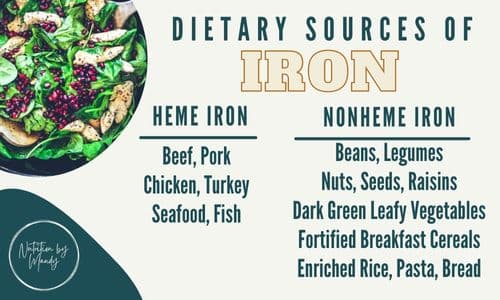
Tips for Helping Athletes Increase Iron Absorption
There are some simple dietary strategies that athletes can use to enhance the body’s absorption of non-heme iron. It can be beneficial to share these tips with athletes trying to boost their iron stores.
Vitamin C and Iron Absorption
Consuming foods and beverages that contain Vitamin C with plant-based sources of iron is a an easy way to help increase the absorption of non-heme iron (1, 7).
Foods containing Vitamin C include:
- Citrus fruits and juices
- Strawberries, blueberries, raspberries
- Cantaloupe, kiwi, mango, papaya
- Tomatoes and tomato juice
- Brussel sprouts, broccoli, bell peppers
Consider the following ideas for combining Vitamin C with iron containing foods:
- Stir fresh berries into cereal at breakfast
- Add diced tomatoes to your chili with beans
- Top your spinach salad with sliced strawberries and colorful bell peppers
- Steam broccoli to eat as a side with rice and chicken at dinner
- Enjoy a tropical smoothie with your overnight oats
Pairing Heme and Nonheme Iron to Enhance Iron Absorption
Consuming sources of heme and nonheme iron together in a meal helps to enhance the absorption of non-heme iron (1).
Thus, athletes should aim to build meals that contain beef, pork, seafood, chicken or turkey, along with plant-based sources of iron. This simple strategy can help to increase the body’s absorption of the nonheme iron.
For example, eating chicken with rice and beans will increase the body’s absorption of the iron from the rice and beans.
Cook in Cast Iron Skillets and Cookware
If athletes enjoy cooking food at home, the use of cast iron skillets and other cookware can help to increase the iron content of the foods they prepare (8).
In particular, meats and acidic foods, as well as foods requiring a long cooking time (i.e., soups), tend to show a significant increase in iron content when prepared in iron cookware (8).
Therefore, cooking in a cast-iron skillet can be an easy step for athletes to take to boost the iron content of their meals.

Factors that Decrease Iron Absorption
When consuming iron-rich foods, it is also important for athletes to be aware that certain nutrients can hinder the body’s absorption of iron.
Impact of Polyphenols on Iron Absorption
Polyphenols are antioxidants found in many plant-based foods. In the body, polyphenols can inhibit the absorption of nonheme iron (7).
Common foods and beverages containing polyphenols include (9):
- Coffee, tea, wine, cocoa
- Cereals, whole grains
- Berries, pomegranates, grapes, apples, citrus fruits, tropical fruits
- Onions, tomatoes, peppers, spinach, legumes
- Walnuts, almonds, hazelnuts, peanuts
- Garlic, turmeric, cinnamon
Although polyphenols may reduce iron absorption, they do provide many other health benefits for athletes. Polyphenols have antioxidant and anti-inflammatory effects in the body and also promote gut health (9).
Thus, athletes are encouraged to consume foods rich in polyphenols in their sports nutrition meal plan. However, to support iron absorption, athletes should avoid consuming these foods at the same time as iron-rich foods.
For example, if athletes enjoy tea and coffee, they should consider drinking these beverages between meals rather than with a meal containing iron-rich foods.
Phytates and Oxalates Impact Iron Absorption
Similar to polyphenols, phytates and oxalates can interfere with nonheme iron absorption by the body (7).
Phytates are naturally occurring antioxidants found in beans, grains, nuts, and seeds. Oxalates are compounds found in plant-based foods such as: tea, kale, spinach, beans, nuts, and chocolate.
Consuming foods and beverages that contain Vitamin C along with foods containing polyphenols, phytates, or oxalates can help counteract the effects these compounds have on iron absorption (7).
What Impact Does Calcium Have on Iron Absorption?
It is important for athletes to be aware that calcium reduces the absorption of both heme and nonheme iron by the body (7).
Calcium is found in milk, yogurt, and other dairy products as well as in many calcium-fortified juices, breakfast cereals, and bars.
Getting adequate calcium in the diet is important for athletes to support bone health. However, athletes looking to boost their iron stores should make sure to consume dairy products, and other foods and beverages containing calcium, separate from iron-rich foods.
In addition, if athletes take an iron supplement, they should take the supplement apart from calcium-rich foods.
Should I Take an Iron Supplement?
I do not recommend that all athletes routinely take an iron supplement. Prior to taking an iron supplement, athletes should have their iron status checked to see if a deficiency exists.
The athlete’s physician or sports dietitian nutritionist can provide guidance on appropriate iron supplementation based upon the lab results.
It is important to recognize that consuming excess iron from supplements can interfere with the absorption of zinc (5). High-dose iron supplements are also frequently associated with gastrointestinal complaints such as constipation, nausea, vomiting, and diarrhea (6).
Excess iron intake is also a concern for athletes at risk for hemochromatosis. Hereditary hemochromatosis is a condition in which iron builds-up in the body’s organs and can cause severe health concerns (10).
Athletes taking iron supplements should regularly have their iron status monitored to prevent an iron overload from occurring (5).
What Time of Day Should an Iron Supplement be Taken?
If an athlete does need to take an iron supplement, taking it in the morning along with a source of vitamin C (i.e., orange juice) is recommended (1, 5, 11).
In addition, athletes should avoid consuming foods that inhibit iron, including milk, tea, and coffee, in the hour before and after taking their iron supplement (5).
The reason for taking an iron supplement in the morning has to do with a hormone in the body called hepcidin.
What is Hepcidin and How Does it Impact Iron Absorption?
Hepcidin is a hormone produced by the liver that controls the absorption and use of iron by the body (12). Elevated hepcidin levels in the bloodstream reduce the absorption of iron by the body.
Hepcidin levels are lowest in the morning and naturally increase over the course of the day (11, 13). Thus, to minimize the inhibitory effect of hepcidin on iron absorption, it is best for athletes to take their iron supplement in the morning.
Does Exercise Impact Hepcidin Levels?
Aside from time of day, exercise also leads to an increase in hepcidin levels. The increase in hepcidin levels in the body tend to peak 3 hours following the exercise session (11).
Thus, it can be helpful to educate athletes on consuming their iron-rich meals and snacks outside of this post-exercise period.
Alternatively, athletes can enjoy an iron-rich snack immediately post exercise (within 30 minutes), prior to the peak in hepcidin levels that inhibit iron absorption (11).
Iron Needs of Vegetarian and Vegan Athletes
Finally, it is important to note that iron may be a nutrient of concern for athletes following a vegetarian or vegan diet.
As discussed above, nonheme iron from plant-based foods is not absorbed by the body as well as heme iron is. In addition, polyphenol, phytates, and oxalates found in many plant foods inhibit the absorption of iron.
Athletes following a vegetarian or vegan diet should routinely monitor their iron status (2). Vegetarian and vegan athletes should also follow the strategies discussed previously for enhancing the absorption of nonheme iron.

Iron for Athletes: Why It Matters and How to Meet Your Needs
You now have an overview of why iron is important for athletes as well as strategies to support athletes with meeting their daily iron needs.
If you have concerns about your current iron intake, consider visiting with a sports dietitian nutritionist. The sports dietitian nutritionist can work with you on developing an individualized meal plan that meets your specific needs.
For additional sports nutrition information, check out my blog with tips on meeting the nutrition needs of teen athletes.
Join the Nutrition By Mandy Email List & Get a Free Athlete’s Grocery List
Click HERE to join the Nutrition By Mandy e-mail list. When you join you will receive a free athlete’s grocery list to print and take with you to the store.
About the Author
Mandy Tyler is a Sports Dietitian Nutritionist in the San Antonio, TX area. She is a Registered and Licensed Dietitian, a Board-Certified Specialist in Sports Dietetics, a Licensed Athletic Trainer, and is a Certified Exercise Physiologist through the American College of Sports Medicine. Mandy has experience working with athletes at the high school, collegiate, and professional levels. She believes the key to reaching one’s full potential, both in everyday life and in sports performance, relies on a healthy nutritional foundation.
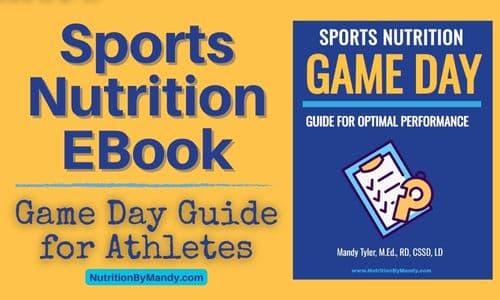
If you are looking to take your performance to the next level, make sure to check out my new Sports Nutrition Game Day Guide. This downloadable guide is written to help athletes develop an individualized plan to achieve peak performance on game day.

